Welcome to Matrix Education
To ensure we are showing you the most relevant content, please select your location below.
Select a year to see courses
Learn online or on-campus during the term or school holidays
Learn online or on-campus during the term or school holidays
Learn online or on-campus during the term or school holidays
Learn online or on-campus during the term or school holidays
Learn online or on-campus during the term or school holidays
Learn online or on-campus during the term or school holidays
Learn online or on-campus during the term or school holidays
Get HSC exam ready in just a week
Select a year to see available courses
Science guides to help you get ahead
Science guides to help you get ahead
There's a lot of ambiguity between a Band 5 and a Band 6 response. Well, don't worry! We'll clear everything up for you.

Join 75,893 students who already have a head start.
"*" indicates required fields
The most common question students ask in English classes is, “What’s the difference between a Band 5 and Band 6 English response?” This is a difficult but important question to answer as there is a lot of confusion and ambiguity around it. In this article, we’ll clear that up for you!
NESA uses the term “Band” or “Bands” to refer to the level or category that your overall HSC English mark sits.
It’s like getting an A – F in your report… but instead, you’re receiving a Band 6 – Band 1.
Here is the breakdown of the HSC marks in different HSC Bands:
| Band | HSC Marks |
| Band 6 | 90-100 |
| Band 5 | 80-89 |
| Band 4 | 70-79 |
| Band 3 | 60-69 |
| Band 2 | 50-59 |
| Band 1 | 0-49 |
Band 6 is the highest Band you can achieve for your overall HSC English mark, whereas Band 1 is the lowest.
This isn’t how most people perceive things, though. Many students have the impression that essays are “Band 6 or Band 5.” This isn’t really correct – there are essays and responses that are reflective of a Band 6 or E4 HSC mark, but that is because they contribute to it.
However, it is crucial that you understand that there is no such thing as a ‘Band 6 essay’, or a ‘Band 5 discursive’.
Your individual responses are given a mark, and then, your overall HSC English mark is given a ‘Band’.
In fact, most marking criteria provided by NESA only have 5 Bands!
Quelle horreur!!
Partly because it is a long-standing misnomer, but also because it is a logical way to quantify the value of an individual response to the overall mark a student wants to achieve. If a student wants a Band 6 HSC result, they need to score in the top echelon for each of their assessment tasks (which are usually scored out of 20 and, thus, have 5 bands, ¯\_(ツ)_/¯ )
So, having cleared that up, for the sake of this article we will use Bands as a way to refer to the marks of your individual responses.
It is important to understand that the standards for the Bands can be slightly different every year (as the student cohort performs differently and to different standards) and for every marker.
Remember, markers are still human; they have feelings, likes and dislikes, and personal values. So, different markers may be impressed by different things.
This means that sometimes the line between a Band 5 and a Band 6 can be very thin. But this is also why essays are cross-marked for the HSC.
Remember, this doesn’t mean that your marks are totally unpredictable!
There is still an important general standard that every marker follows to determine your mark! That is the marking criteria.
All of the markers have to adhere to these criteria and justify their decisions against them.
So, let’s break down the marking criteria to see what you need to do to get yourself in the “Band 5” or “Band 6” range!
Don’t worry. We will help you get that Band 6 mark! Our HSC experts will guide you through English and provide you with actionable feedback that will boost your marks. Learn more now!
NESA provides you with marking criteria and sample responses for every module! Ensure that you take some time to look over these in detail.
We will be using these to help us find the difference between a Band 4, 5, and 6 response.
So, let’s get started:
Note: It is crucial that you understand what each NESA key word means and requires you to do when you are breaking down the marking criteria. So, take a read of our How to Respond to NESA Key Words article to help you get through this one!
Paper 1 is divided into 2 sections: the reading task and the essay.
Let’s take a look at the Paper 1 marking criteria from NESA:
Let’s break down some marking criteria for Standard Paper 1 questions (note how it only has 4 bands, but we’ll quantify these, and the rest, out of 6)).

From a glance, it’s easy to identify the difference between a Band 4 and Band 5.
However, it is much more difficult to distinguish the differences between a Band 5 and Band 6 response…
What is the difference between ‘analyse how’ and ‘analyse effectively’?
Let’s find out:
| Band 4 | Band 5 | Band 6 | |
| Differences | 1. ‘Describes…’ | 1. ‘Analyses…’ | 1. ‘Analyse effectively…’ |
| Meaning | 1. “Provide characteristics and features” This means that you simply recount the text without providing any real techniques. | 1. “Identifies the relationship between the different components.” This means that you identify some techniques and examples and attempted to explain it. However, your ideas may not answer the whole question, be articulated clearly or be in enough depth. | 1. “Identifies the relationship between the component and explain how and why” This means that you are able to demonstrate a strong understanding of the text. There is a clear thesis and suitable textual evidence to support your argument. |
| Example | The song represents a contradictory experience of loss and hope as the woman leaves behind her current life and family to follow her wedded American husband after the war. The line ‘she held her mother as she cried’ demonstrates that there is loss because she won’t see her mother forever. However, the line in the next stanza says, ‘she was holding the future in her hand’, illustrating that her future is full of hope as she reunites with her American husband. | The song explores a contradictory experience of loss and hope as the woman leaves behind her current life and family to follow her wedded American husband after the war. The use of future tense like ‘A daughter that he’s yet to see’ demonstrates a sense of hope. There is also an uplifting tone with words like ‘Yankee’, ‘sea’ and ‘free’. However, the line, ‘leaving a southern land,’ illustrates that she is leaving her home. | “The song expresses the contradictory experience of young women being hopeful about beginning a new life with their husbands in America and the sense of loss that results from leaving Australia and their family. It has a positive tone expressed through the repetition in the chorus of ‘the home of the brave and the land of the free’. This uplifting tone is also created by the assonance created by the words ‘Yankee’, ‘sea,’ and ‘free’. However, there is a sense of the vast distances that separate the women from family depicted through the images of travel through contrasting landscapes ‘across the sea’, ‘through desert plains . . . driving rain’. The use of the phrase ‘leaves a southern land’ reinforces the sense that this voyage will take the women away from home forever.” |
Note: A full list of NESA Key Verbs can be found in our How to Respond to NESA Key Verbs article
Advanced questions often require more from the students, compared to Standard questions.
Remember, you aren’t simply being marked on your analysis, you are also marked on your writing skills!
Let’s take a look at the information provided in NESA’s 2019 Sample English Advanced Paper 1 Marking Criteria:
| Band 4 | Band 5 | Band 6 | |
| Differences | 1. ‘Explains the significance…’ 2. ‘Demonstrates variable control…’ | 1. ‘Explains effectively the significance…’ 2. ‘Demonstrates sound control…’ | 1. ‘Explains skilfully’ 2. ‘Demonstrates developed control’ |
| Meaning | 1. ‘Relate the cause and effect’. You list specific evidence and describes it. However, you don’t go into a deeper exploration of the ideas. 2. Writing fluctuates. There may be some awkwardly composed sentences, or grammatical, spelling, or punctuation errors.
| 1. ‘Identify the cause and effect, and the purpose and functions ‘ You explain how certain features and elements create meaning and relate it to the purpose. However, your response may not answer the question wholly or lack insight and/or depth. 2. Writing is composed well. However, there may be some grammatical, spelling or punctuation errors. | 1. ‘Identify the cause and effect, and the purpose and functions ‘ You provide an insightful thesis with relevant and strong evidence to support it. They answer the question wholly and in depth. 2. You write with purpose and intent. It is composed well and has little or no errors. |
| Example | Answers could include: “Memories may be fragmented and disconnected until there is a catalyst that stimulates the act of remembering. The series of phrases indicating the beginning of the journey into the past ‘so I turned, randomly’ suggests that remembering is a process…” “Remembering can offer a new perspective on a life’s experiences or significant relationships. The act of recollection can invite a personal reassessment of the present. The use of parentheses reveals the protagonist’s inner thoughts about the people around him…” “The protagonist expresses a sense of wonderment in the final revelation of memory, expressed in the concluding repetition of ‘remembering’ and the exaltation expressed in ‘I remembered everything.“ | ||
You might notice that some questions overlap between Standard and Advanced, and others don’t.
Often, the marking criteria for a shared Advanced and Standard question is different to an Advanced only or Standard only question.
Let’s take a look at a shared 7 marker question:
Notice how the criteria has more similarity to an Advanced marking criteria than a Standard one?
The distinguishing factors between a Band 6 and a Band 5 are the difference between ‘skilfully’ and ‘effectively’. (We already went through this in the Advanced section)
However, unlike Advanced, it doesn’t have the additional assessment of your writing skills.
NESA provides the same marking criteria for English Standard and Advance Common Module Essay.
Here is what it looks like:
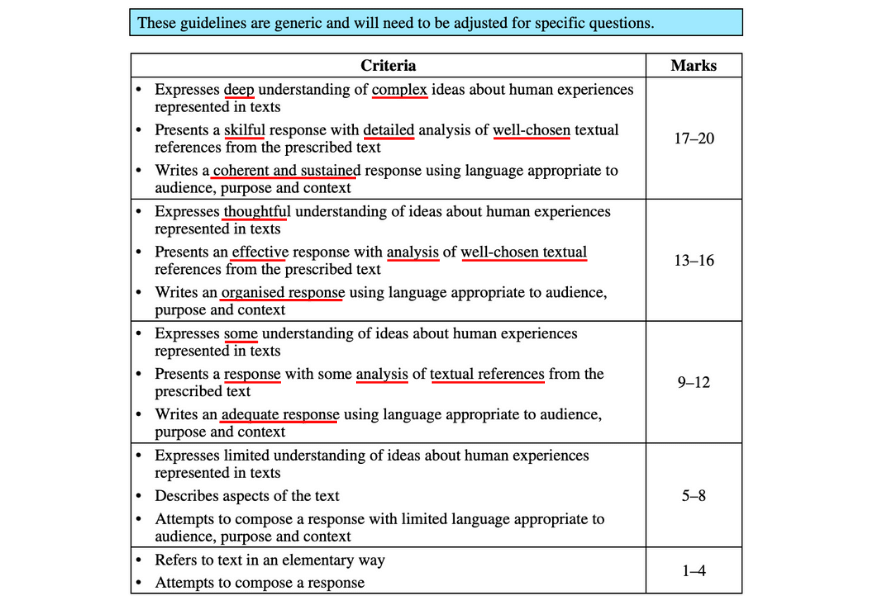
| Band 4 | Band 5 | Band 6 | |
| Differences | 1. ‘Some understanding of ideas’ 2. ‘A response with some analysis’ 3. ‘Textual references’ 4. ‘Adequate response’ | 1. ‘Thoughtful understanding of ideas’ 2. ‘Effective response with detailed analysis’ 3. ‘Well chosen textual references’ 4. ‘Organised response’ | 1. ‘Deep understanding of complex ideas’ 2. ‘Skilful response with detailed analysis’ 3. ‘Well chosen textual evidence’ 4. ‘Coherent and sustained response’ |
| Meaning | 1. Your analysis fails to deeply dig into the themes and messages. 2. You are describing/explaining the example, instead of analysing. 3. You make references to the text, but you are not selecting strong/high-order techniques. 4. Your ideas aren’t structured, coherent and sustained throughout your response. | 1. You may need to draw a stronger connection between the text’s themes, it’s context and your current context. 2. You analyse the techniques well. However, your link to the real world is not strong enough. 3. You carefully select strong evidence that supports your thesis. 4. Your response has a clear structure and idea flows well. However, you sometimes stray from your thesis/question. | 1. You successfully explore the themes related to the Human Experience and draw strong connections between the text and the real world. You also determine the significance of the text’s themes. 2. You write with purpose and intent, and you explore deep themes and link it to the real world. 3. You carefully select strong evidence that supports your thesis. 4. You clearly sustain your thesis/question throughout the whole essay. |
Let’s break down Module A’s rubrics for both Standard and Advanced:
| Band 4 | Band 5 | Band 6 | |
| Differences | 1. ‘Analyses adequately…’ 2. ‘Presents a response…’ 3. ‘Adequate textual knowledge…’ 4. ‘Expresses ideas adequately…’ 5. ‘Using language appropriate to audience, purpose and form…’ | 1. ‘Analyses competently…’ 2. ‘Presents a competent response…’ 3. ‘Sound textual knowledge…’ 4. ‘Organises, develops and expresses ideas competently…’ 5. ‘Competently using language appropriate to audience, purpose and form…’ | 1. ‘Analyses effectively…’ 2. ‘Effective response…’ 3. ‘Detailed textual knowledge…’ 4. ‘Organises, develops and expresses ideas effectively…’ 5. ‘Effectively language appropriate to audience, purpose and form…’ |
| Meaning | 1. Your analysis lacks depth. You also need to draw a stronger link to the text’s context. 2. You write a response. 3. You make links to the text. However, they are not always strong, insightful, or relevant. 4. You are not always expressing your ideas clearly. 5. Your writing style reflects your audience, thesis and form. | 1. You analyse the text well. However, it may be lacking deeper insight. 2. Your response is fairly well written, there may be errors. 3. Some of your evidence may not be strong or relevant to your arguments. 4. Your response is well structured. However, there are areas where your ideas are weak, or you don’t sustain your thesis. 5. Your writing style shows a consideration of your audience, your purpose and the form. | 1. Your analysis is strong and logical. 2. Your response is purposeful, logical and well written. 3. Your evidence is carefully selected. They are relevant, strong and insightful. 4. Your response has a clear and purposeful structure. You write with coherence and sustain your thesis/question throughout the essay. 5. Your writing demonstrates technicality, and a high consideration of your audience, purpose and form. |
NESA 2019 English Advanced Sample Paper 1: Module A
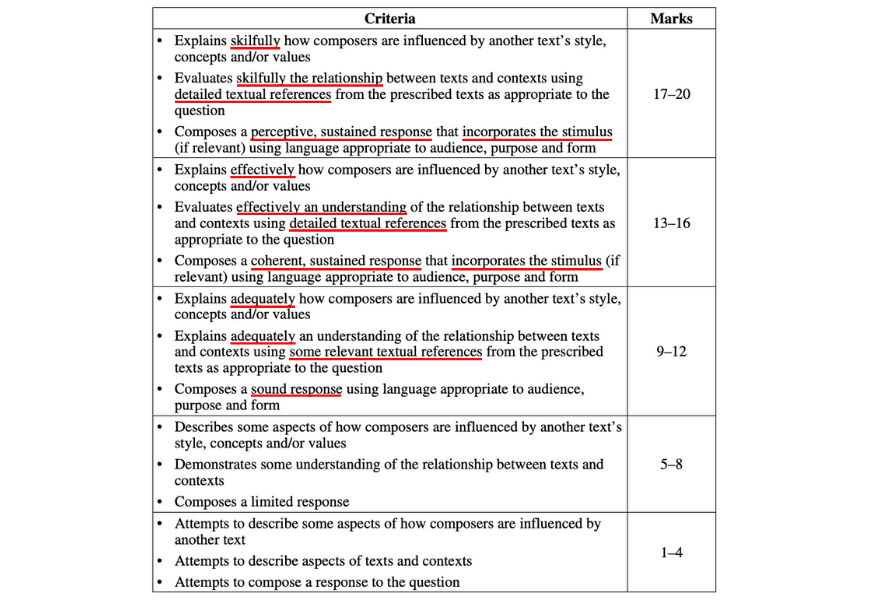
| Band 4 | Band 5 | Band 6 | |
| Differences | 1. ‘Explain adequately how composers…’ 2. ‘Explains adequately an understanding of the relationships…’ 3. ‘Some relevant textual references’ 4. ‘Sound responses’ 5. — | 1. ‘Explains effectively how composers…’ 2. ‘Evaluates effectively an understanding of the relationships…’ 3. ‘Detailed textual references’ 4. ‘Coherent, sustained response’ 5. ‘Incorporates the stimulus’ | 1. ‘Explains skilfully how composers…’ 2. ‘Evaluate skilfully the relationship between texts and contexts’ 3. ‘Detailed textual references’ 4. ‘Perceptive, sustained response’ 5. ‘Incorporates the stimulus’ |
| Meaning | 1. Your thesis and ideas provide an explanation for the composer’s influences. However, you fail to go into more depth. 2. You demonstrate a sound understanding of the relationship between texts. However, it is lacking depth, insight and evaluation. 3. Your textual references relate to your thesis/question. 4. Your writing shows some consideration of your audience, purpose and form. There is a structure, but you don’t sustain your ideas very well. 5. You don’t consider the stimulus at all (where relevant). | 1. You provide a strong explanation for the composer’s influences. 2. You analyse the significance of a relationship between texts, well. 3. Your textual analysis is relevant to your thesis/question and you break it down in detail. 4. Your thesis/ideas are logical and you sustain your argument throughout the response well. Your writing is purposeful. 5. The stimulus is well integrated into your response (where relevant). | 1. You provide an insightful explanation about the composer’s influences. It is also well written and purposeful. 2. Your analysis is well written and relevant. You make a judgement about the significance of the relationship between texts. 3. Your textual analysis is relevant to your thesis/question and you break it down in detail. 4. Your ideas and themes are highly insightful. You consider the text’s significance in the world. You also sustain your ideas throughout your response and write purposefully. 5. The stimulus is well integrated into your response (where relevant). |
Let’s break down Module B’s rubrics for both Standard and Advanced:
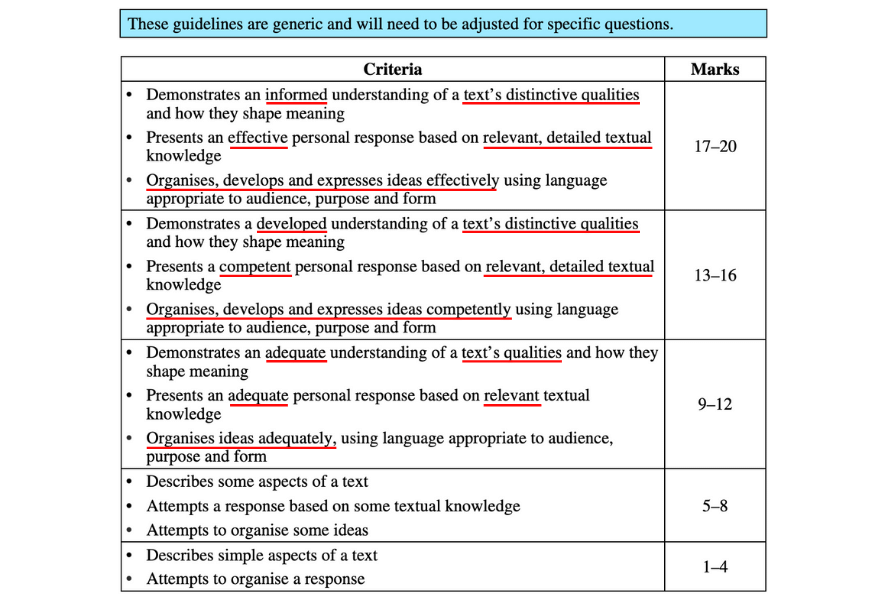
| Band 4 | Band 5 | Band 6 | |
| Differences | 1. ‘Adequate understanding of a text’s qualities…’ 2. ‘Adequate personal response…’ 3. ‘Relevant textual knowledge…’ 4. ‘Organises ideas adequately…’ | 1. ‘Developed understanding of a text’s distinctive qualities…’ 2. ‘Competent personal response’ 3. ‘Relevant, detailed textual knowledge…’ 4. ‘Organises, develops and expresses ideas competently…’ | 1. ‘Informed understanding of text’s distinctive qualities…’ 2. ‘Effective personal response…’ 3. ‘Relevant, detailed textual knowledge…’ 4. Organises, develops and expresses ideas effectively…’ |
| Meaning | 1. Demonstrates some understanding of the text’s features. 2. Your writing includes some consideration of your personal experience, context and thoughts. 3. You make references to the text that relate to your thesis. However, your analysis lacks detail. 4. You structure your ideas clearly. | 1. Demonstrate a good understanding of the function of the text’s unique features. 2. Your writing demonstrates a good consideration of your personal experience, context and thoughts. 3. Your references to the text directly relates to your thesis/question and is detailed. 4. Your structure demonstrates a clear and logical flow of ideas. | 1. Demonstrate a strong and knowledgeable understanding of the function of the text’s unique forms and features. 2. You present a convincing response that shows a high consideration of your personal experiences, context and thoughts. 3. Your references to the text directly relates to your thesis/question and is detailed. 4. Your structure demonstrates a clear and logical flow of ideas. |
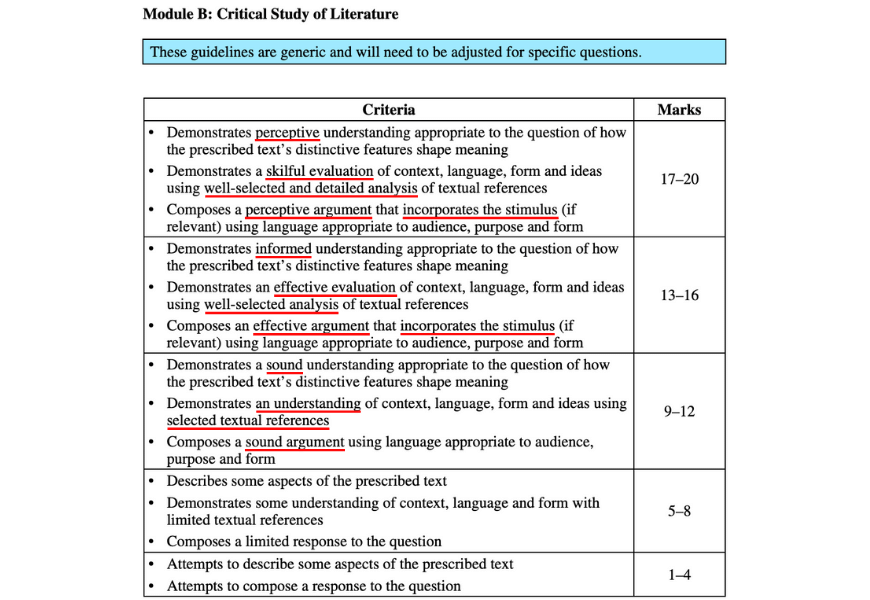
| Band 4 | Band 5 | Band 6 | |
| Differences | 1. ‘Sound understanding appropriate to the question…” 2. ‘An understanding of context, language, form and ideas…’ 3. ‘Selected textual references…’ 4. ‘Sound argument…’ 5. — | 1. ‘Informed understanding appropriate to the question…’ 2. ‘Effective evaluation of context, language, form and ideas…’ 3. ‘Well-selected analysis of textual references…’ 4. ‘Effective argument…’ 5. ‘Incorporates the stimulus…’ | 1. ‘Perceptive understanding appropriate to the question…’ 2. ‘Skilful evaluation of context, language, form and ideas…’ 3. ‘Well-selected and detailed analysis of textual references’ 4. ‘Perceptive argument…’ 5. ‘Incorporates the stimulus’ |
| Meaning | 1. You demonstrate a good understanding of how the text’s unique feature creates meaning. 2. Your response demonstrates that you understand the relationship between context, language, form and ideas. 3. You’ve made references to the text and found some evidence. 4. You make good arguments. 5. You fail to incorporate the stimulus into your response (where relevant). | 1. Your response shows that you have given great thought about how the text’s unique features create meaning by linking it to the purpose. 2. Your response shows that you’ve evaluated the significance of the relationship between context, language, form and ideas. 3. You carefully select strong textual analysis that directly supports your ideas. 4. Your arguments are compelling. 5. Your response is obviously based/inspired off of your stimulus. It is incorporated inside your response (where relevant). | 1. You demonstrate an informed and insightful understanding of how the text’s unique features create meaning. You give purpose and explore its significance in the real world. 2. Your writing is purposeful and insightful, and effectively evaluates the significance of the relationship between context, language, form and ideas. 3. You select strong, and relevant textual analysis and break it down to support your argument. 4. Your argument is compelling and provides deep insight into the text and the wider world. 5. Your response is obviously based/inspired off of your stimulus. It is incorporated inside your response (where relevant). |
Module C can require you to write an imaginative, discursive, reflection, or a persuasive… So, it’s best to be prepared for all!
Let’s go through Mod C’s marking criteria:
This marking criteria is used for an imaginative, discursive or persuasive:
| ‘I must go down to the seas again, to the lonely sea and the sky…’ John Masefield, Sea FeverOR‘A lie gets halfway around the world before the truth has a chance to get its pants on.’ Sir Winston ChurchillUse ONE of the lines above as a stimulus for the opening of an imaginative, discursive or persuasive piece of writing. In your piece of writing incorporate at least ONE example of figurative language that you have learned about through your study of the prescribed texts for Module C. |
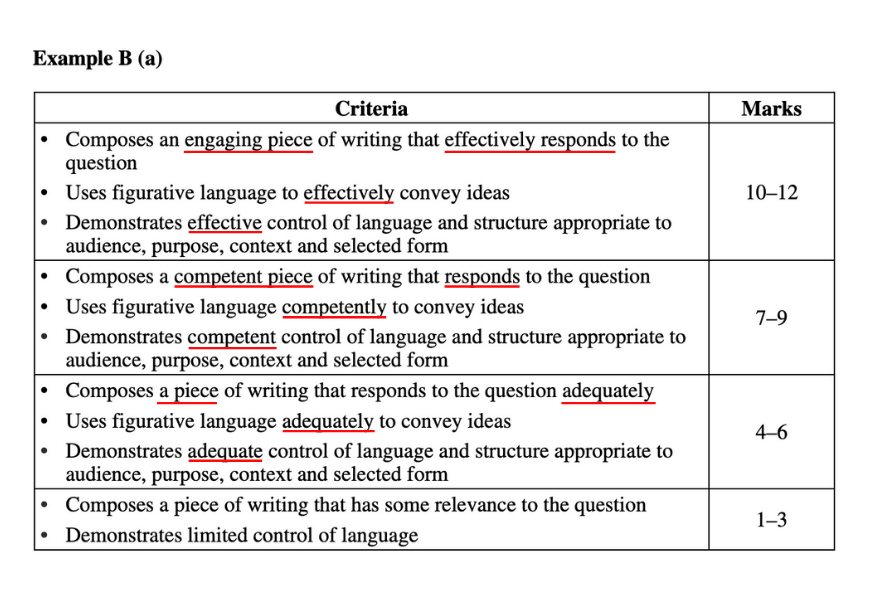
| Band 4 | Band 5 | Band 6 | |
| Differences | 1. ‘A piece of writing…’ 2. ‘Responds to the question adequately’ 3. ‘Uses figurative language adequately…’ 4. ‘Demonstrates adequate control of language and structure…’ | 1. ‘A competent piece of writing’ 2. ‘Responds to the question’ 3. ‘Uses figurative language competently’ 4. ‘Demonstrates competent control…’ | 1. ‘An engaging piece of writing’ 2. ‘Effectively responds to the question’ 3. ‘Uses figurative language to effectively convey ideas’ 4. ‘Demonstrates effective control…’ |
| Meaning | 1. Your response follows the conventions of your chosen form. 2. Your response somewhat answers the question. 3. You use some figurative language to get your message across. However, it may not be strong or used appropriately. 4. You show some consideration of your audience, purpose and form through your language and structure. However, it is still unclear. | 1. Your response is well written. 2. Your response answers the question, but it may not be sustained or insightful. 3. You appropriately use figurative language to convey a message. 4. You used an appropriate structure and language for your particular audience, purpose and form. | 1. Your response is well written and hooks the audience’s interest. 2. You sustain your answer (thesis/main idea) throughout the whole response and it is insightful. 3. Your use of figurative language is purposeful and conveys the message strongly. Everything works together. 4. Your writing style and structure is purposeful and shows high consideration of your audience, purpose and form. |
This Advanced question gives you the choice of writing a persuasive, discursive or imaginative piece.
| ‘Guard your roving thoughts with a jealous care, for speech is but the dealer of thoughts, and every fool can plainly read in your words what is the hour of your thoughts.’ Alfred Lord Tennyson Use this warning as a stimulus for a piece of persuasive, discursive or imaginative writing that expresses your perspective about a significant concern or idea that you have engaged with in ONE of your prescribed texts from Module A, B or C. |
| Band 4 | Band 5 | Band 6 | |
| Differences | 1. ‘A sound piece of writing…’ 2. ‘Responds to question satisfactorily’ 3. ‘Uses language competently to convey…’ 4. ‘Demonstrates sound control of language and structure…’ | 1. ‘A piece of writing’ 2. ‘Responds to question effectively’ 3. ‘Crafts language effectively to convey’ 4. ‘Demonstrates effective control of language and structure…’ | 1. ‘An engaging piece of writing’ 2. ‘Responds to question skilfully’ 3. ‘Crafts language skilfully to convey…’ 4. ‘Demonstrates skilful control of language and structure…’ |
| Meaning | 1. You produce a response 2. You answer the question. However, more insight and thought is needed. 3. You demonstrate some control of language to convey a particular message. 4. You demonstrate an understanding of how language and structure is important in conveying particular messages to | 1. You produce a good response. 2. You provide a well-thought and logical answer to the question. 3. You use writing techniques to convey a particular message effectively. 4. Your use of language and structure is highly appropriate for your audience, purpose and form of writing. | 1. Your response is well written, hooks the audience in and shows personality. 2. You answer the question throughout your whole response. Your answer is insightful and demonstrates a high understanding of the task. 3. You successfully manipulate your writing (structure, form, figurative language…) to convincingly convey a particular message. 4. Your control of language and structure is purposeful. You demonstrate a high consideration of your audience, purpose and form of writing. |
Now you’ve got an understanding of what differentiates a Band and Band 5 response, you need to work on how to achieve one. So, how do you go about that?
Good luck on your quest!
Written by Matrix English Team
The Matrix English Team are tutors and teachers with a passion for English and a dedication to seeing Matrix Students achieving their academic goals.© Matrix Education and www.matrix.edu.au, 2023. Unauthorised use and/or duplication of this material without express and written permission from this site’s author and/or owner is strictly prohibited. Excerpts and links may be used, provided that full and clear credit is given to Matrix Education and www.matrix.edu.au with appropriate and specific direction to the original content.